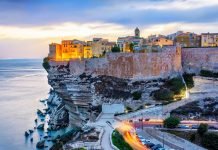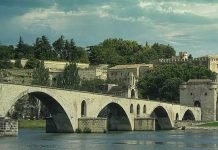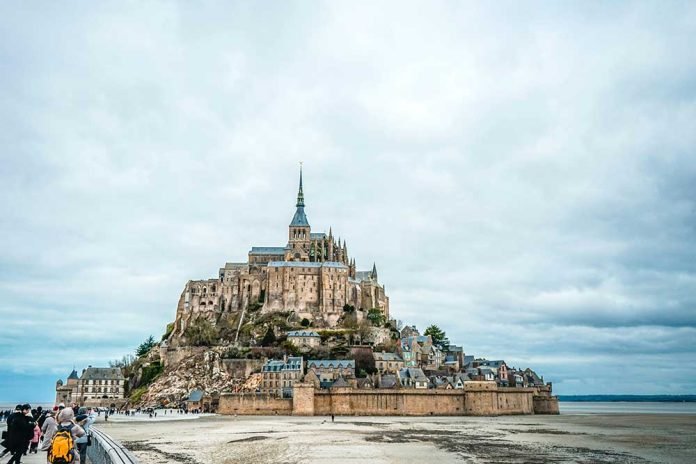Mont Saint-Michel isn’t merely a destination, it’s a journey through time, faith, and natural splendor. This fusion of spiritual grandeur, historical importance, and natural beauty make it more than a must-see tourist spot, but a significant touchstone of French culture. Whether it’s the spiritual seeker, the history aficionado, or the nature enthusiast, Mont Saint-Michel extends an invitation for all to discover its many marvels and stories. The abbey atop Mont Saint-Michel is a remarkable example of Gothic architecture and is dedicated to the Archangel St. Michael.Today, Mont Saint-Michel is one of the most visited sites in France, attracting approximately 2.5 million visitors each year. If you’re planning a visit to Mont Saint-Michel, it is recommended to explore the neighboring regions of Brittany and Normandy as well. Consider basing yourself in Rennes, a city that offers convenient access to both regions.
Strategic Location
Mont Saint-Michel is known for its gravity-defying abbey and picturesque surroundings, situated on a small granite outcrop that is almost circular in shape, with a circumference of about 3,000 feet (900 meters).The island is made of leucogranite, which formed from an underground intrusion of molten magma approximately 525 million years ago during the Cambrian period.
The abbey sits atop the highest point of Mont Saint-Michel, providing a commanding view of the surrounding landscape. Its location was strategically chosen for both spiritual and defensive purposes. The island’s isolation during high tide made it an ideal sanctuary for religious contemplation, while its fortified walls and position made it a defensible stronghold.
In the ensuing centuries, the strategic position of Mont Saint-Michel between Normandy and Brittany turned it into a critical defensive fortress during the Hundred Years’ War. The abbey also served as a prison under Louis XI, symbolizing the tumultuous relationship between spirituality and politics through French history.
Architecture
The abbey is a stunning combination of Romanesque and Gothic architectural styles. It was constructed in multiple phases over several centuries, resulting in a unique blend of architectural elements. The abbey’s soaring spires, pointed arches, ribbed vaults, and intricate stone carvings are characteristic of Gothic design.
Inside the abbey, visitors can explore the grand halls, cloisters, and chapels. The Abbey Church is the centerpiece, featuring stunning stained glass windows, ornate altars, and a magnificent choir. The abbey also houses a collection of religious artifacts, manuscripts, and artwork that showcase the rich spiritual history of the site.
The Mystical Beginnings: St. Michael and Mont Saint-Michel
According to legend, the founding of Mont Saint-Michel as a sacred site is deeply connected to the Archangel St. Michael, one of the principal angelic figures in Christian tradition. Renowned as a protector and a leader of the heavenly armies against the forces of evil, St. Michael holds a significant place in various religious traditions, including Christianity, Judaism, and Islam. Here’s a more detailed look into the legend, significance, and the pilgrimages associated with Mont Saint-Michel:
The Vision of Saint Aubert:
In the early 8th century, it is said that St. Michael appeared to Aubert, the bishop of Avranches, in a series of dreams. In these visions, the archangel instructed Aubert to build a church atop the rocky island that would later become Mont Saint-Michel. Initially, Aubert was hesitant to undertake such a monumental task. Legend has it that St. Michael became so insistent that he burnt a hole in Aubert’s skull with his finger to make his point clear. Consequently, Saint Aubert heeded the vision and initiated the construction of a church on the island around 709 AD. This small sanctuary would be the seed from which the grand Mont Saint-Michel Abbey would eventually grow.
St. Michael: The Patron and Protector:
Dedicated to the Archangel St. Michael, the abbey naturally placed this celestial figure at the heart of its spiritual life. For centuries, people believed that St. Michael’s powerful and protective presence permeated Mont Saint-Michel. The archangel was considered the patron saint of the island, and his reputed role as the defender against evil made the abbey a place of profound spiritual significance. The abbey, perched high upon a rock and surrounded by the sea, physically embodies the celestial isolation of St. Michael, mirroring his lofty, untouchable purity and strength.
Pilgrimage: A Journey for Spiritual Solace and Blessings:
From the Middle Ages onwards, Mont Saint-Michel became one of Europe’s most important pilgrimage destinations. People from various walks of life, including kings, bishops, and common folk, undertook arduous journeys to reach this sacred island. Pilgrims believed that by traveling to Mont Saint-Michel, they could come into closer contact with the divine protection and grace of St. Michael. The journey itself, often fraught with danger and hardship, was seen as an act of penance and devotion that could cleanse the soul.
In addition to seeking personal spiritual enlightenment and protection, many pilgrims traveled to Mont Saint-Michel as an act of devotion during times of societal strife, such as war or plague, praying for St. Michael’s protection over their lands and people.
The Abbey as an Architectural Testament:
The abbey itself is a marvel of medieval architecture, with its gothic spires, stout defensive walls, and delicate flying buttresses. The architecture seems to pay homage to its patron, St. Michael, with its lofty perch and celestial air. It stands as a testament to the deep faith that inspired its construction and the reverence in which St. Michael was held. Notably, the statue of St. Michael that tops the spire of the abbey depicts the archangel in a triumphant pose, slaying a dragon – a representation of his role as a defender of the faithful against evil.
Contemporary Relevance:
Today, Mont Saint-Michel continues to draw visitors from around the world. While some come as tourists, attracted by the island’s stunning beauty and rich history, others are modern-day pilgrims, seeking spiritual solace, enlightenment, and a sense of connection with the divine. Regardless of their reasons for visiting, many people report a sense of awe and spiritual depth when they set foot on the island, which continues to be a space where the mundane and the sacred converge in a powerful way.
The Geomantic Mystique: Energy Lines and Spiritual Power
The Geomantic Mystique: Energy Lines and Spiritual Power of Mont St Michel
In the esoteric world, Mont Saint-Michel is not just an architectural marvel and historical site; it is also revered as a potent spiritual nexus. Long before the term ‘geomancy’ was coined, people sensed a certain spiritual magnetism about Mont Saint-Michel, which perhaps contributes to its centuries-long appeal as a pilgrimage site. Below is an expanded discussion of Mont Saint-Michel in the context of geomancy, energy lines, and spiritual power.
Mont Saint-Michel as a Geomantic Point:
Geomancy, deriving from the Greek roots ‘geo,’ meaning ‘earth,’ and ‘mancy,’ meaning ‘divination,’ is an ancient practice that involves understanding the relationships between the spiritual and physical worlds through the earth’s energies. According to geomantic traditions, the earth is crisscrossed with lines of energy, sometimes referred to as ‘ley lines.’ These lines connect various significant sites around the world, such as ancient monuments, sacred sites, and places of natural beauty or power. Mont Saint-Michel is believed by some to be a prominent point on these energy lines.
The Apollo-Athena Line:
One of the most famous ley lines in geomantic studies is the Apollo-Athena Line. This line is said to stretch from the British Isles, through continental Europe, and into the Middle East, linking a series of spiritually significant sites along its path. According to this tradition, Mont Saint-Michel is a key point on this line. Geomantic scholars suggest that this line represents a sort of spiritual ‘highway,’ and the sites that lie along it – including Mont Saint-Michel – are believed to be charged with a potent spiritual energy.
The Spiritual Magnetism of Mont Saint-Michel:
For centuries, Mont Saint-Michel has been a destination for pilgrims. The site’s reputed position on the Apollo-Athena Line is believed by some to contribute to its profound spiritual magnetism. Even for visitors who are not explicitly spiritual, many report a sense of awe and wonder when visiting Mont Saint-Michel, which could be interpreted as an encounter with this spiritual energy.
Contemporary Pilgrimages and Earth Energy Experiences:
In recent years, there has been a resurgence of interest in ancient spiritual practices and earth energies. Mont Saint-Michel has thus become a destination not only for traditional Christian pilgrims but also for those interested in more esoteric spiritual experiences. These modern pilgrims, often referred to as ‘earth energy seekers,’ visit Mont Saint-Michel in hopes of connecting with the powerful energy they believe flows through this site. Some visitors engage in practices such as meditation, dowsing, or yoga during their visits, attempting to attune themselves to the island’s purported energy.
Skeptical Views and Scientific Perspectives:
It is important to note that the concept of ley lines and the geomantic significance of Mont Saint-Michel are matters of belief and are not universally accepted. Skeptics argue that ley lines are the product of coincidence and human pattern recognition rather than manifestations of tangible energy. From a scientific standpoint, there is currently no empirical evidence to support the existence of ley lines or earth energy in the way that geomancy describes.
Regardless of one’s perspective on geomancy and ley lines, Mont Saint-Michel undeniably holds a deep and enduring fascination for people around the world. Whether visitors are drawn by its architectural majesty, its rich history, its spiritual significance, or the promise of hidden earth energies, Mont Saint-Michel remains one of the world’s most captivating and enigmatic sites—a place where the earthly and the spiritual seem to meet and intertwine in profound and mysterious ways.
A Sanctuary of Biodiversity
The island and its bay have been listed as a UNESCO World Heritage Site since 1979, not only for their cultural significance but also for their exceptional natural environment. The tidal variations around Mont Saint-Michel are indeed one of the most dramatic in the world, and these tides play a significant role in shaping the ecosystems of the bay. Below is an expansion on the diverse range of bird, marine, and terrestrial species found in the environs of Mont Saint-Michel:
Bird Species:
- Waders and Shorebirds: These are some of the most noticeable inhabitants of the bay. Species such as the common redshank, curlew, oystercatcher, and dunlin are a common sight, probing the mudflats for invertebrates at low tide.
- Ducks and Geese: The bay’s nutrient-rich waters attract a variety of waterfowl. Mallards, teal, and shelducks are commonly observed, as well as brent geese in winter.
- Raptors: Birds of prey, such as the peregrine falcon and the marsh harrier, are drawn to the bay due to its abundant prey.
- Seabirds: Gulls (including herring gulls and great black-backed gulls) and cormorants are often seen flying over the bay or resting on its shores.
- Migratory Birds: Mont Saint-Michel Bay is an important stopover site for migratory birds traveling along the East Atlantic Flyway. Examples include the knot, godwits, and sandpipers.
Marine Species:
- Fish: The dynamic tidal movements of the bay create a productive environment for various fish species. Examples include bass, mullet, and sole, which are abundant in these waters.
- Mollusks: The mudflats are rich in various species of mollusks, including common cockles, mussels, and various species of clams.
- Crustaceans: The bay is home to a variety of crustaceans, including the common shore crab and the European green crab.
Terrestrial Species:
- Mammals: Various mammals are found in the bay’s surrounding areas, including European otters and small rodent populations.
- Plants and Vegetation: The salt meadows around Mont Saint-Michel are characterized by halophytic (salt-tolerant) plants. Examples include sea lavender, samphire, and sea aster. These plants play a crucial role in stabilizing the mudflats and providing habitat for various species.
- Invertebrates: The mudflats are rich in various species of worms and small crustaceans, which provide a vital food source for the bay’s bird populations.
Conservation and Management:
The bay’s unique ecosystems are delicate and sensitive to human activity. Over the years, sedimentation has been increasing due to human-made changes to the Couesnon River, which feeds into the bay. In recent decades, initiatives have been launched to restore the natural flow of the river and reduce sedimentation in the bay, aiming to preserve the unique environment of Mont Saint-Michel and its surroundings for future generations.



















